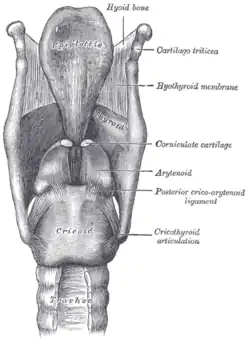
Larynx with corniculate cartilages indicated at center.

The horned puffin Fratercula corniculata
Corniculate, an Anglicisation of the Latin diminutives corniculata, corniculatum, and corniculatus, describes an object possessing hornlike extensions.[1] The root is Latin cornu = "horn". The term is used to describe the shape of the corniculate cartilages of the larynx. The horned puffin (Fratercula corniculata) is named for its distinctive horn-like coloration. Likewise Oxalis corniculata (creeping woodsorrel) is named for its two erect capsules, which resemble little horns,[2][3] and the bird's-foot trefoil Lotus corniculatus[4] and goat's horn mangrove Aegiceras corniculatum[5] are named for their horn-shaped fruits.
References
- ↑ "Farlex free dictionary:Corniculate".
- ↑ "Flora of Australia Online". ABRS.
- ↑ See photograph Archived 2009-04-08 at the Wayback Machine
- ↑ "030 II Bird's Foot -Trefoil Lotus corniculatus L." British-wild-flowers.com. Archived from the original on 2011-05-25. Retrieved 2009-09-21.
- ↑ "Noosa's Native Plants:Aegiceras corniculatum". Note photo.
This article is issued from Wikipedia. The text is licensed under Creative Commons - Attribution - Sharealike. Additional terms may apply for the media files.